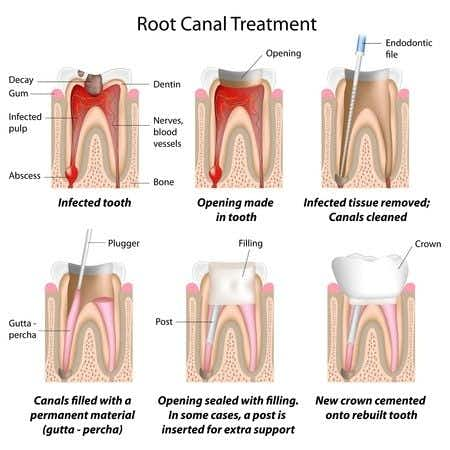A dental expert witness advises on case involving a patient who accused dentists of malpractice for root canal treatment. Plaintiff sought treatment from defendant dentist for two painful teeth. The defendant referred took radiographs then referred plaintiff to defendant endodontist for a root canal of one tooth and crowns for that tooth and one other. The endodontist performed the root canal. Additional radiography was taken. Plaintiff returned to the defendant dentist for follow-up care. The dentist took additional radiographs and prepared the two teeth for crowns. A few days later, the dentist filled two teeth, and advised plaintiff that one of those teeth and several others might require a root canal in the future. A few days later, the dentist placed caps on the first two teeth. The entire treatment by the defendant dentist and endodontist lasted one month.
Several years later, plaintiff underwent root canal treatment by another dentist, and a file on one of the crowned teeth was discovered. Plaintiff alleges he suffered injury, specifically the placement of a crown by the defendants over one tooth that contained a separated file. He also claims he was suffering infections after the root canal therapy.
Plaintiff filed one claim for professional negligence. He alleges they negligently and carelessly examined, diagnosed, treated, advised, failed to advise or inform him, causing him to suffer injuries and damages.
Question(s) For Expert Witness
1. What is the standard of care?
2. Did the defendants violate it?
Expert Witness Response
All of the treatment by the dentist was within the standard of care, and any injury plaintiff suffered was not caused by negligence.
It was within the standard of care for the dentist to refer plaintiff to an endodontist for an evaluation, and it was within the standard of care for the dentist to recommend crowns for the two teeth. During plaintiff’s examination, he had pain in the area of those teeth and the radiographs reveal he had existing restorations on those teeth. There was also decay present and a radiolucency in the area of one tooth. Based on these findings, a referral for possible root canal therapy and the recommendation for crowns was appropriate.
The endodontist’s radiographs taken after the root canal therapy do not show a separated file. The dentist’s radiographs taken when plaintiff returned to his office following the root canal do not show a separated file in the tooth.
The root canal therapy performed by the endodontist was within the standard of care, as the canals were filled to their radiographic apex.
It was within the standard of care for the dentist to prepare two teeth for crowns. Following root canal therapy, the treated tooth is typically restored with a crown. It was also appropriate to prepare the other tooth for a crown due to the presence of decay.
The crowns seated were within the standard of care. Radiographs reveal the crowns appropriately fit the teeth. It was also within the standard of care for the dentist to place fillings on teeth due to his finding of decay. Further, it was appropriate for the dentist to note plaintiff may require possible root canal therapy and crowns. Root canal therapy and crowns are appropriate treatment for decayed teeth and/or old crowns that are failing.
Notably, even if there was a separated file present in the tooth at the time the dentist saw plaintiff to place a crown, it was not below the standard of care to place the crown. Crowns can be placed on teeth by general dentists following the performance of root canal therapy by
endodontists when separated files have been left within the tooth by the endodontists.
The expert is a dentist with more than 30 years of experience.
About the author
Kristin Casler
Kristin Casler is a seasoned legal writer and journalist with an extensive background in litigation news coverage. For 17 years, she served as the editor for LexisNexis Mealey’s litigation news monitor, a role that positioned her at the forefront of reporting on pivotal legal developments. Her expertise includes covering cases related to the Supreme Court's expert admissibility ruling in Daubert v. Merrell Dow Pharmaceuticals Inc., a critical area in both civil and criminal litigation concerning the challenges of 'junk science' testimony.
Kristin's work primarily involves reporting on a diverse range of legal subjects, with particular emphasis on cases in asbestos litigation, insurance, personal injury, antitrust, mortgage lending, and testimony issues in conviction cases. Her contributions as a journalist have been instrumental in providing in-depth, informed analysis on the evolving landscape of these complex legal areas. Her ability to dissect and communicate intricate legal proceedings and rulings makes her a valuable resource in the legal journalism field.



